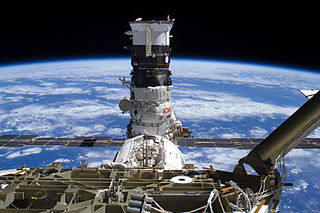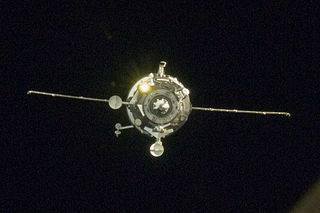Related Research Articles

The International Space Station (ISS) is the largest modular space station in low Earth orbit. The project involves five space agencies: the United States' NASA, Russia's Roscosmos, Japan's JAXA, Europe's ESA, and Canada's CSA. The ownership and use of the space station is established by intergovernmental treaties and agreements. The station serves as a microgravity and space environment research laboratory in which scientific research is conducted in astrobiology, astronomy, meteorology, physics, and other fields. The ISS is suited for testing the spacecraft systems and equipment required for possible future long-duration missions to the Moon and Mars.

The Automated Transfer Vehicle, originally Ariane Transfer Vehicle or ATV, was an expendable cargo spacecraft developed by the European Space Agency (ESA), used for space cargo transport in 2008–2015. The ATV design was launched to orbit five times, exclusively by the Ariane 5 heavy-lift launch vehicle. It effectively was a larger European counterpart to the Russian Progress cargo spacecraft for carrying upmass to a single destination—the International Space Station (ISS)—but with three times the capacity.

Fyodor Nikolayevich Yurchikhin is a Russian cosmonaut of Greek descent, engineer and RSC Energia test-pilot who has flown on five spaceflights. His first spaceflight was a 10-day Space Shuttle mission STS-112. His second was a long-duration stay aboard the International Space Station (ISS) as a flight engineer for Expedition 15; for this mission he was launched in the Soyuz TMA-10 spacecraft. He has undertaken two further long-duration stays aboard the ISS, as a crew member of Expedition 24 / 25. For this mission he was launched with the spacecraft Soyuz TMA-19, and he landed in November 2010, also with the Soyuz TMA-19 spacecraft. He served as Soyuz commander for his fourth mission aboard Soyuz TMA-09M, as flight engineer for Expedition 36 and ISS commander for Expedition 37. In April 2017, Yurchikhin launched on Soyuz MS-04 for the fifth spaceflight of his career, a six-month mission to the ISS as part of Expedition 51 and 52, for which he was the commander.

Zvezda, Salyut DOS-8, also known as the Zvezda Service Module, is a module of the International Space Station (ISS). It was the third module launched to the station, and provided all of the station's life support systems, some of which are supplemented in the US Orbital Segment (USOS), as well as living quarters for two crew members. It is the structural and functional center of the Russian Orbital Segment (ROS), which is the Russian part of the ISS. Crew assemble here to deal with emergencies on the station.

A space rendezvous is a set of orbital maneuvers during which two spacecraft, one of which is often a space station, arrive at the same orbit and approach to a very close distance. Rendezvous requires a precise match of the orbital velocities and position vectors of the two spacecraft, allowing them to remain at a constant distance through orbital station-keeping. Rendezvous may or may not be followed by docking or berthing, procedures which bring the spacecraft into physical contact and create a link between them.

Expedition 14 was the 14th expedition to the International Space Station (ISS). Commander Michael López-Alegría, and flight engineer Mikhail Tyurin launched from Baikonur Cosmodrome on 18 September 2006, 04:09 UTC, aboard Soyuz TMA-9. They joined Thomas Reiter, who had arrived at the ISS on 6 July 2006 aboard Space Shuttle Discovery during mission STS-121. In December 2006, Discovery mission STS-116 brought Sunita Williams to replace Reiter as the third member of Expedition 14. On 21 April 2007, López-Alegría and Tyurin returned to Earth aboard TMA-9. Landing occurred at 12:31:30 UTC.

Mir-2 was a Soviet space station project which began in February 1976. Some of the modules built for Mir-2 have been incorporated into the International Space Station (ISS). The project underwent many changes, but was always based on the DOS-8 base block space station core module, built as a back-up to the DOS-7 base block used in the Mir station. The DOS-8 base block was eventually used as the Zvezda module of the ISS. Its design lineage extends back to the original Salyut stations.

Kurs is a radio control system used by the Soviet and later Russian space program.

The process of assembling the International Space Station (ISS) has been under way since the 1990s. Zarya, the first ISS module, was launched by a Proton rocket on 20 November 1998. The STS-88 Space Shuttle mission followed two weeks after Zarya was launched, bringing Unity, the first of three node modules, and connecting it to Zarya. This bare 2-module core of the ISS remained uncrewed for the next one and a half years, until in July 2000 the Russian module Zvezda was launched by a Proton rocket, allowing a maximum crew of three astronauts or cosmonauts to be on the ISS permanently.

The Jules Verne ATV, or Automated Transfer Vehicle 001 (ATV-001), was a robotic cargo spacecraft launched by the European Space Agency (ESA). The ATV was named after the 19th-century French science-fiction author Jules Verne. It was launched on 9 March 2008 on a mission to supply the International Space Station (ISS) with propellant, water, air, and dry cargo. Jules Verne was the first of five ATVs to be launched.

Poisk, also known as the Mini-Research Module 2, Малый исследовательский модуль 2, or МИМ 2, is a docking module of the International Space Station. Its original name was Docking Module 2, as it is almost identical to the Pirs Docking Compartment. Added in 2009, Poisk was the first major Russian addition to the International Space Station since 2001. Poisk is overall the same design as the docking module Pirs. Whereas Pirs was attached to the nadir ("bottom") port of Zvezda, Poisk is attached to the zenith ("top"); Pirs was closer to the Earth with the ISS in its usual orientation, and Poisk is on the other side. Poisk is Russian for explore or search. Poisk combines various docking, EVA, and science capabilities. It has two egress hatches for EVAs in addition to the two spacecraft docking ports. Although Poisk is designated as Mini-Research Module 2, it arrived before Mini-Research Module 1 (Rassvet), which had a different design; Poisk looks more like the Pirs docking port, which is not designated as a mini-research module.

The Russian Orbital Segment (ROS) is the name given to the components of the International Space Station (ISS) constructed in Russia and operated by the Russian Roscosmos. The ROS handles Guidance, Navigation, and Control for the entire Station.

The Johannes Kepler ATV, or Automated Transfer Vehicle 002 (ATV-002), was an uncrewed cargo spacecraft built to resupply the International Space Station (ISS). It was launched on February 16, 2011 by the European Space Agency (ESA). Johannes Kepler carried propellant, air and dry cargo weighing over 7,000 kilograms (15,000 lb), and had a total mass of over 20,000 kilograms (44,000 lb), making it, at the time, the heaviest payload launched by the ESA. The spacecraft was named after the 17th-century German astronomer Johannes Kepler.
TriDAR, or Triangulation and LIDAR Automated Rendezvous and Docking, is a relative navigation vision system developed by Neptec Design Group and funded by the Canadian Space Agency and NASA. It provides guidance information that can be used to guide an unmanned vehicle during rendezvous and docking operations in space. TriDAR does not rely on any reference markers positioned on the target spacecraft. Instead, TriDAR relies on a laser based 3D sensor and a thermal imager. TriDAR's proprietary software uses the geometric information contained in successive 3D images to match against the known shape of the target object and calculate its position and orientation.

The European contribution to the International Space Station comes from 10 members of the European Space Agency (ESA) and amounts to an 8% share in the programme. It consists of a number of modules in the US Orbital Segment, ATV supply ships, launchers, software and €8 billion.

Progress M-17M, identified by NASA as Progress 49P, was a Progress spacecraft used by Roskosmos to resupply the International Space Station during 2012. The seventeenth Progress-M 11F615A60 spacecraft to launch, it had the serial number 417 and was built by RKK Energia. It was the 130th launch to the ISS and the twentieth Russian space launch in 2012. It was also the eleventh mission for the R-7 family of rockets since the beginning of the year.

Progress M-19M, identified by NASA as Progress 51P, is a Progress spacecraft used by Roskosmos to resupply the International Space Station during 2013. Progress M-19M was launched on a standard 2-day rendezvous profile towards the ISS. The 19th Progress-M 11F615A60 spacecraft to be launched, it had the serial number 419 and was built by RKK Energia.
Sistema Stykovki i Vnutrennego Perekhoda, SSVP is a docking standard used by Soviet and Russian spacecraft, sometimes called RDS for Russian Docking System. It has been used on all variants of Soyuz other than the Soyuz 7K-L3 and early flights of the Soyuz 7K-OK, as well as Progress, TKS, ATV, and on all Soviet and Russian space stations.

Soyuz MS-14 was a Soyuz spaceflight to the International Space Station. It carried no crew members, as it was intended to test a modification of the launch abort system for integration with the Soyuz-2.1a launch vehicle. It launched successfully on 22 August 2019 at 03:38 UTC. It was the first mission of the Soyuz crew vehicle without a crew in 33 years, and the first ever unpiloted mission of Soyuz to the ISS.

Progress MS-18, Russian production No. 447, identified by NASA as Progress 79P, was a Progress spaceflight operated by Roscosmos to resupply the International Space Station (ISS). This was the 170th flight of a Progress spacecraft.
References
- ↑ "State of the art in automatic rendezvous". European Space Agency. 2 April 2004.